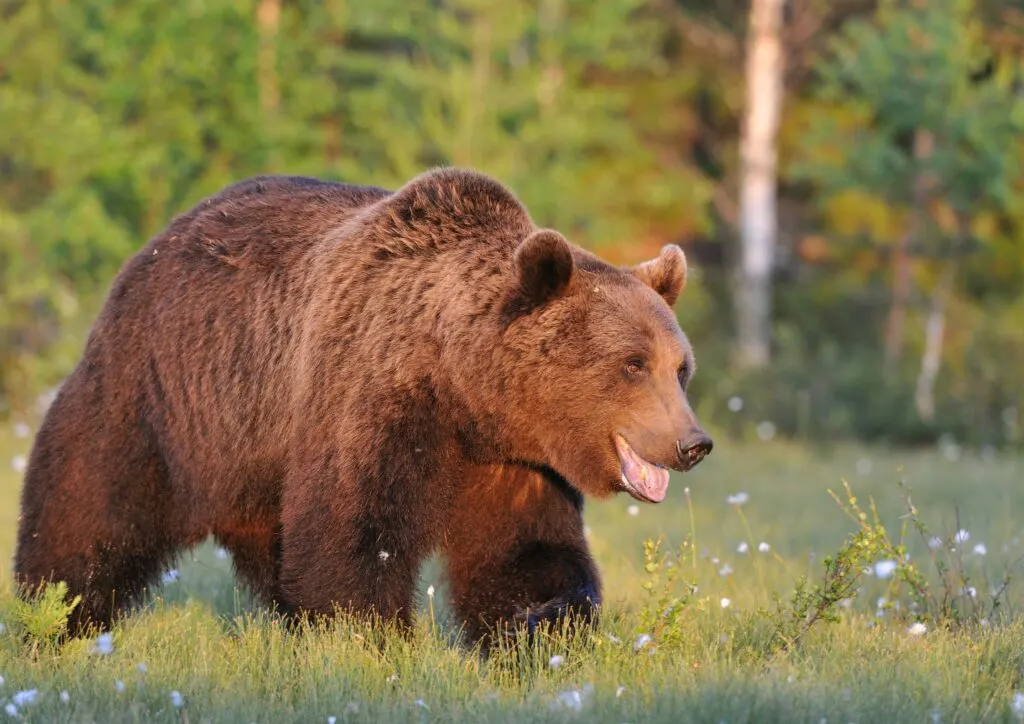Yes, there are bears in Colorado. There have been reported sightings of bears throughout the state over the years. Residents have also reported bear break-ins.
In this article, we will delve deeper into what you need to know about bears in Colorado.
Types of Bears in Colorado
Colorado has a history of hosting two types of bears: Black Bears and Grizzly Bears. Black bears are generally found in mountainous areas while grizzly bears are unfortunately considered to be locally extinct. The last recorded Grizzly bear sighting was in 1951.
Black Bears

These beasts are commonly found in many parts of Colorado, especially in mountainous and forested areas. Even though they are black bears, some of them are blonde, cinnamon and brown.
They usually stay away from people but can become a problem if they start to associate humans with food. To avoid this, Colorado residents are advised to properly store their food and trash so that bears aren’t attracted to it.
Black bears eat a wide variety of things including berries, insects and small animals, but they can also be found eating food that people leave out, like birdseed, pet food, and unsecured trash.
Keep in mind that it is illegal and dangerous to feed bears in Colorado.
Grizzly Bears
Grizzly bears are not found in Colorado naturally, but sometimes people see them. These are usually young male bears that make their way from a nearby area called the Greater Yellowstone Ecosystem.
Even though grizzly bear sightings in Colorado are very rare, hikers or people who enjoy the outdoors might come across a wandering bear occasionally and therefore, should know how to be safe and what to do if they see one.
When are the Bears most Active in Colorado?
In Colorado, bears are most likely to be seen during the fall, spring, and summer months. During these seasons, bears are searching for food to build up fat stores for the winter.
During the winter months, bears hibernate and are less active, so you are less likely to see them.
The best time to spot a bear is from mid-March to November.
Where are the Bears most Active in Colorado?
Bears typically live in areas where there is a lot of natural food. Usually, they stay away from people and prefer to live in areas of wilderness. However, on rare occasions, bears may wander into areas where people live.
State Parks
There are a number of stunning national parks in Colorado where you can see bears.
Some of the most popular ones include Black Canyon of the Gunnison National Park, Rocky Mountain National Park, and Great Sand Dunes National Park and Preserve.
You can also see bears in several nearby forest reserves, like the Uncompahgre National Forest and the Arapaho and Roosevelt National Forests. If you are interested in seeing bears in the wild, these are great places to visit!
Bear Sightings & Activity
Bear sightings are most common in the western and southern regions of the state, particularly in the foothills and mountainous areas.
However, bears can also be found in the eastern plains, even though sightings are less frequent.
Camping & Backpacking
If you go camping or backpacking in Colorado, you might see bears in the wild. But it’s important to be careful and make sure that you do nothing that would pose a threat to you or the bears.
This means keeping your food and trash away from bears, carrying bear spray, and knowing how to use it. You should also be aware of your surroundings and make noise so bears know you are there.
Before you go, check with the local ranger station to find out if there have been any recent bear sightings.
With the right preparation and knowledge, camping and backpacking in bear country can be a fun and exciting experience. So, we suggest you learn about bear behaviour and what to do if you meet one.
Related: Can you eat bears in Alaska?
Bear Hunting – Hunting Season
In Colorado, bear hunting season generally occurs in the fall.
A valid hunting license and a bear hunting permit are required. Different hunting units have their own regulations and quotas, and hunting methods (using bait or hunting with hounds) may also vary by unit.
Check the regulations for the specific unit you plan to hunt in, and you should consider attending a bear hunting class prior to hunting.
Conservation Efforts
Volunteer programmes
There are numerous volunteer programmes in Colorado for those interested in bear conservation. Some of them include the following:
- Rocky Mountain Wild: This organisation offers volunteer opportunities for those who like to assist with bear research and monitoring projects in the Rocky Mountain region.
- Colorado Parks and Wildlife: This state agency offers various volunteer opportunities, including assisting with bear-proofing campsites and educating the public about bear safety and conservation.
- The Wild Animal Sanctuary: A 789-acre sanctuary for large carnivores that have been rescued from captivity. They have a volunteer program which includes working with their animals, including bears and helping with the maintenance of the sanctuary. There are also internships, and you can even make donations.
Have there been any fatal Bear attacks?
Bear attacks are not common in Colorado, but they can happen. Most of the time, bears will try to stay away from people.
However, if a person comes across a bear and the bear feels scared or threatened, it might attack.
Safety and Awareness Tips
Here are some safety precautions you should take:
- Store your food and trash in bear-proof containers or by hanging them from a tree.
- Learn how to use bear spray
- Make noise while hiking so that you won’t surprise a bear.
- Keep a safe distance of at least 100 yards from bears.
- If you encounter a bear, stay calm and back away slowly while facing the bear.
- Never feed or approach bears; this can lead to habituation and increase the risk of human-bear conflicts.
- Watch out for bear tracks

